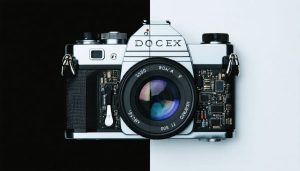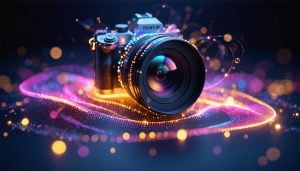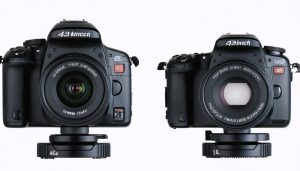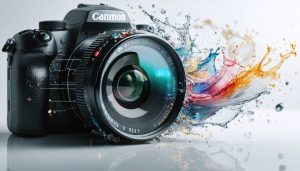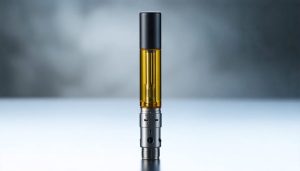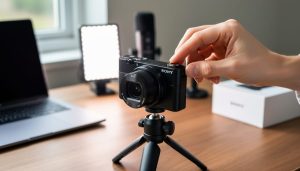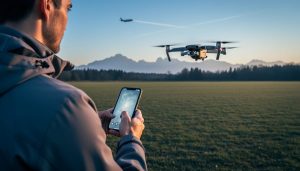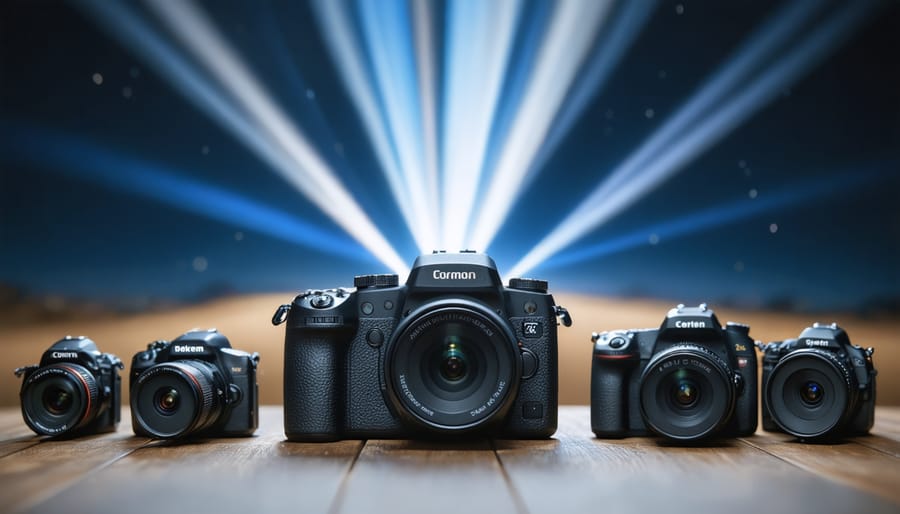
Image sensor size dramatically shapes your photography, influencing everything from low-light performance to depth of field and overall image quality. While megapixels often steal the spotlight in camera marketing, sensor size plays an equally crucial – if not more important – role in determining how your photos will look.
Think of camera sensors like solar panels: larger sensors capture more light, just as bigger solar panels harvest more energy. A full-frame sensor (36x24mm) collects roughly four times more light than a Micro Four Thirds sensor (17.3x13mm), resulting in better low-light performance and richer dynamic range. This fundamental difference explains why professional photographers often invest in cameras with larger sensors, despite their higher cost and bulkier size.
But bigger isn’t always better. Smaller sensors, like those found in modern smartphones and compact cameras, offer distinct advantages in portability, extended reach for wildlife photography, and often lower cost. Understanding these tradeoffs is essential for making informed decisions about your photography equipment.
In this comprehensive guide, we’ll explore how different sensor sizes compare, examine their real-world impact on image quality, and help you determine which size best suits your photographic needs. Whether you’re considering upgrading your camera or simply wanting to understand why your images look the way they do, this sensor size comparison will provide the clarity you need.
Understanding Image Sensor Sizes
Common Sensor Formats
In the world of digital photography, common sensor formats vary significantly, each offering unique benefits for different photography styles. Full Frame sensors, measuring 36x24mm, match the dimensions of traditional 35mm film and are favored by professionals for their superior low-light performance and shallow depth of field capabilities.
APS-C sensors, found in many enthusiast cameras, are approximately 1.5x smaller than full-frame (1.6x for Canon). These sensors offer an excellent balance between image quality and portability, making them popular among wildlife and sports photographers due to their “crop factor” advantage for telephoto shooting.
Micro Four Thirds sensors, measuring 17.3x13mm, represent a compact yet capable format. This system pioneered the mirrorless camera revolution and continues to offer exceptional portability without sacrificing image quality.
The 1-inch sensor format (13.2×8.8mm) has become increasingly popular in premium compact cameras and bridge cameras. While smaller than the above formats, modern 1-inch sensors deliver impressive image quality that far exceeds smartphone capabilities.
At the smaller end, we find 1/1.7-inch and 1/2.3-inch sensors common in compact cameras and smartphones. Despite their size limitations, technological advances have helped these sensors achieve remarkable results, especially when paired with computational photography techniques.
Size Comparison Visualization
When comparing image sensor sizes, it’s helpful to visualize them side by side. The most common sensor sizes, from smallest to largest, arrange like nested rectangles. A full-frame sensor (36mm × 24mm) serves as our reference point, roughly equivalent to a frame of 35mm film. APS-C sensors, measuring approximately 23.6mm × 15.7mm (Nikon) or 22.2mm × 14.8mm (Canon), occupy about 40% of the full-frame area.
Moving down the scale, Micro Four Thirds sensors (17.3mm × 13mm) take up roughly 25% of full-frame space. One-inch sensors (13.2mm × 8.8mm), popular in premium compact cameras, occupy about 12% of full-frame area. The smallest commonly found sensors in smartphones and compact cameras are typically 1/2.3-inch (6.17mm × 4.55mm) or even smaller.
To put this in perspective, imagine laying a postage stamp (full-frame) on your desk. An APS-C sensor would be about the size of a large postage stamp, while a 1/2.3-inch sensor would be closer to the size of your pinky fingernail. This dramatic size difference directly impacts light-gathering capability, depth of field control, and overall image quality.
Understanding these relative sizes helps explain why larger sensors generally produce better low-light performance and allow for more dramatic background blur in portraits.
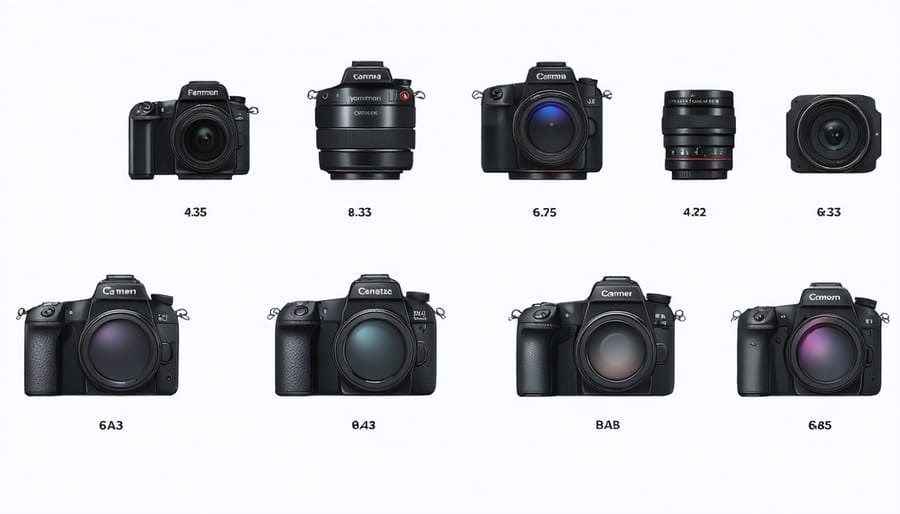
How Sensor Size Affects Image Quality
Light Gathering Capability
One of the most significant advantages of larger image sensors is their superior light-gathering capability. Think of each pixel on a sensor as a bucket collecting light – larger sensors have bigger “buckets,” allowing them to capture more light with less noise. In our full frame vs APS-C comparison, this difference becomes particularly evident in challenging lighting conditions.
For example, when shooting in dim environments like concert venues or twilight landscapes, a full-frame sensor will typically deliver cleaner, more detailed images than a smaller sensor at the same ISO settings. This is because the larger surface area allows for better signal-to-noise ratio, resulting in images with less digital noise and better dynamic range.
Consider this practical scenario: shooting a wedding reception in a dimly lit venue. A photographer using a camera with a larger sensor can maintain lower ISO settings while still achieving well-exposed images, preserving more detail and color accuracy. Conversely, a smaller sensor might require higher ISO settings to achieve the same exposure, potentially introducing more noise into the final image.
This improved light-gathering capability also translates to better performance in astrophotography, night photography, and indoor sports photography, where available light is often limited and artificial lighting isn’t always an option.
Depth of Field Control
One of the most noticeable effects of sensor size is its impact on depth of field – the range of distance in your image that appears acceptably sharp. Larger sensors generally create a shallower depth of field, allowing photographers to achieve that coveted background blur, also known as bokeh.
Here’s why: with a larger sensor, you need to either get closer to your subject or use a longer focal length to achieve the same framing as a smaller sensor. This combination of factors results in more pronounced background blur when shooting at the same aperture. For instance, a full-frame sensor shooting at f/2.8 will produce noticeably more background blur than a micro four-thirds sensor at the same f-stop and equivalent field of view.
This characteristic makes larger sensors particularly appealing for portrait photographers and anyone wanting to isolate their subjects from the background. However, smaller sensors have their advantages too – they make it easier to achieve greater depth of field, which is particularly useful in landscape and architectural photography where you want everything in sharp focus.
Consider this practical example: shooting a portrait at f/2.8 with a 50mm lens will produce significantly different results on different sensor sizes. A full-frame camera will create dreamy, blurred backgrounds, while an APS-C sensor will retain more background detail, and a smartphone sensor will keep most of the scene in focus.
Dynamic Range and Color Depth
One of the most significant advantages of larger image sensors is their superior dynamic range and color depth capabilities. When you have a larger sensor, each pixel site can be bigger, allowing it to capture more light and information. This translates into better tonal gradation and more subtle color variations in your images.
Larger sensors typically capture a wider range of brightness levels, from the deepest shadows to the brightest highlights. This expanded dynamic range means you’ll retain more detail in high-contrast scenes, like a sunset where you want to capture both the bright sky and darker landscape elements. You might notice this particularly when shooting in challenging lighting conditions, where smaller sensors might struggle to maintain detail in both bright and dark areas.
The color reproduction benefits are equally impressive. Larger pixels can collect more color information, resulting in smoother color transitions and more accurate color rendering. This is especially noticeable in subtle shade variations, like the different tones in a blue sky or the delicate color transitions in skin tones.
For instance, full-frame sensors often deliver 14-bit or higher color depth, capable of capturing billions of distinct colors, while smaller sensors might be limited to 12-bit depth. This difference becomes apparent in post-processing, where images from larger sensors generally provide more flexibility for color adjustment without degrading image quality.
Real-World Image Comparisons
Low-Light Performance
When it comes to low-light photography, sensor size plays a crucial role in image quality. Larger sensors generally perform better in challenging lighting conditions, thanks to their ability to capture more light. This becomes particularly evident when comparing smaller sensor formats to their larger counterparts.
Full-frame sensors excel in low-light situations, allowing photographers to shoot at higher ISOs while maintaining cleaner images with less noise. For instance, a full-frame camera at ISO 6400 might produce images comparable in quality to an APS-C sensor at ISO 3200 or a Micro Four Thirds at ISO 1600. This advantage becomes particularly noticeable during indoor events, concert photography, or nighttime street photography.
The larger photosites (pixel sites) on bigger sensors collect more light, resulting in better signal-to-noise ratios. This means you can push your camera’s capabilities further in challenging conditions without compromising image quality. For example, wedding photographers often prefer full-frame cameras for dimly lit reception halls, where flash photography might be restricted.
However, modern sensor technology has significantly improved low-light performance across all sizes. Even smaller sensors can now produce impressive results in challenging conditions, especially when paired with wide-aperture lenses and effective image stabilization systems. The key is understanding your equipment’s limitations and working within them to achieve the best possible results.
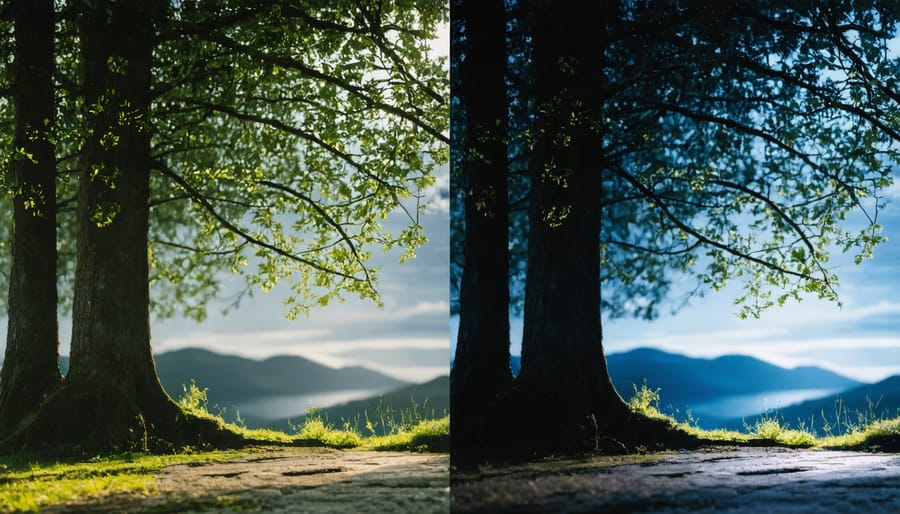
Portrait Photography
Portrait photography is where sensor size differences truly shine, particularly when it comes to creating that coveted background blur and subject separation. Larger sensors, like full-frame and medium format, naturally produce a shallower depth of field compared to smaller sensors when shot at the same aperture and equivalent focal length.
For instance, shooting a headshot at f/2.8 with a 50mm lens will produce noticeably different results across formats. A full-frame sensor will create smoother, creamier background blur than an APS-C sensor, while a medium format sensor takes this effect even further. This characteristic makes larger sensors particularly appealing for portrait photographers who want to achieve that professional-looking separation between subject and background.
However, it’s worth noting that smaller sensors aren’t necessarily at a disadvantage. Many photographers successfully create stunning portraits with APS-C and Micro Four Thirds cameras by leveraging faster aperture lenses and careful composition. The key is understanding how to work with your sensor size’s characteristics.
When shooting environmental portraits, larger sensors also offer wider field of view at the same focal length, allowing you to include more context while maintaining natural perspective. This can be particularly useful when working in tight spaces or trying to capture both the subject and their surroundings in a single frame.
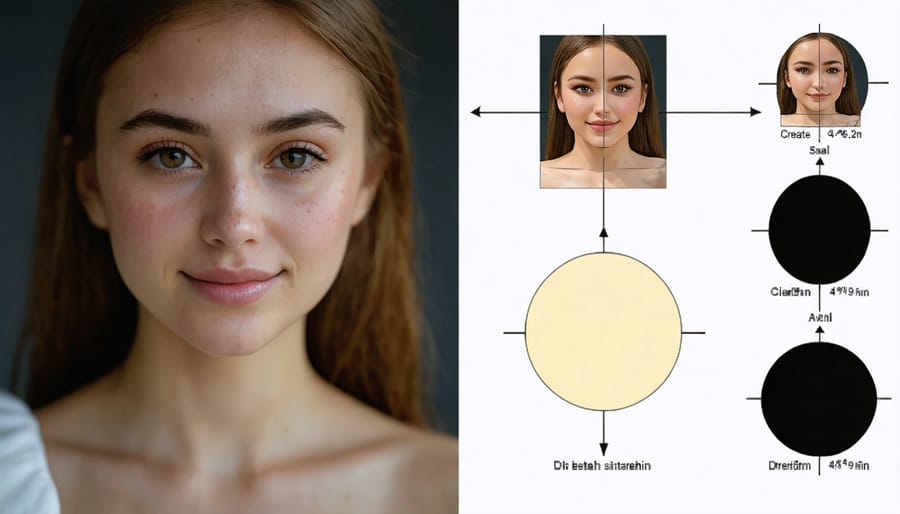
Landscape Photography
Landscape photography demands exceptional detail retention and dynamic range, areas where sensor size plays a crucial role. Larger sensors, particularly full-frame and medium format, excel at capturing the subtle gradations in sky colors during sunrise and sunset, while maintaining detail in both shadows and highlights.
When shooting landscapes in challenging lighting conditions, such as during golden hour or in high-contrast scenes, larger sensors demonstrate their superiority in dynamic range. A full-frame sensor typically captures 1-2 stops more dynamic range than an APS-C sensor, allowing you to retain more information in both the bright sky and darker foreground elements in a single exposure.
Detail retention is another area where larger sensors shine. With their bigger photosites, full-frame and medium format sensors capture more light per pixel, resulting in cleaner images with better detail preservation, especially in shadow areas. This becomes particularly noticeable when making large prints or cropping images.
However, smaller sensors aren’t without their advantages in landscape photography. The crop factor can effectively increase the reach of your lenses, which can be beneficial when photographing distant subjects. Additionally, smaller sensors often offer greater depth of field at equivalent apertures, making it easier to achieve front-to-back sharpness in your compositions.
The key is matching your sensor choice to your specific landscape photography needs and shooting style. While larger sensors generally offer better image quality, factors like portability, budget, and specific shooting requirements should influence your decision.
Practical Considerations
Cost vs. Performance
When it comes to image sensor size, there’s often a direct correlation between size and cost, but the relationship isn’t always straightforward. Larger sensors generally command higher prices, with full-frame sensors typically being the most expensive option in consumer cameras. For example, a full-frame mirrorless camera might cost $2,000-3,000, while an APS-C camera with similar features could be found for $800-1,500.
However, the value proposition isn’t just about the initial cost. Larger sensors often deliver better low-light performance, superior dynamic range, and that coveted shallow depth of field, which might justify the investment for professional photographers or serious enthusiasts. On the flip side, smaller sensors have become increasingly capable, offering excellent image quality at a fraction of the cost.
Micro Four Thirds and APS-C sensors represent an attractive middle ground, offering a compelling balance of performance and affordability. These formats deliver professional-grade image quality while keeping both camera and lens costs manageable. For instance, a complete Micro Four Thirds kit with several lenses might cost the same as a single full-frame camera body.
Consider your specific needs when evaluating cost versus performance. If you’re primarily shooting in good light and don’t require extreme shallow depth of field, a smaller sensor might offer the best value. Conversely, if you frequently shoot in challenging lighting conditions or need the ultimate in image quality, the higher cost of a larger sensor could be a worthwhile investment.
Portability and Lens Considerations
When choosing a camera system, sensor size significantly influences the overall portability and lens options available to you. Larger sensors like full-frame typically require bigger, heavier lenses to cover their imaging area, while smaller sensors allow for more compact lens designs. This lens quality impact is particularly noticeable when comparing systems side by side.
For example, a full-frame mirrorless camera with a professional 24-70mm f/2.8 lens might weigh around 1.5kg, while a Micro Four Thirds system with equivalent field of view could weigh half as much. This difference becomes crucial when traveling or shooting for extended periods.
Lens availability also varies considerably between formats. Full-frame systems generally offer the widest selection of lenses, from ultra-wide to super-telephoto options. APS-C formats maintain a good balance, with manufacturers producing both high-end and budget-friendly options. Smaller sensors like Micro Four Thirds benefit from naturally smaller lenses but may have fewer ultra-wide-angle options due to their crop factor.
Consider your shooting style and mobility needs when choosing a system. Street photographers might prefer the discretion of a smaller sensor system, while landscape photographers could prioritize the extensive lens selection of full-frame systems, despite the added weight.
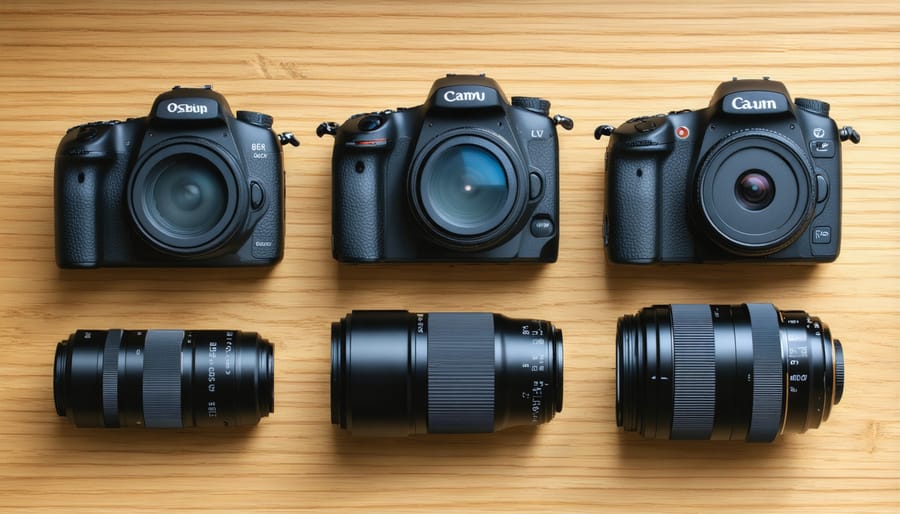
Understanding sensor size is crucial for making informed photography decisions, and as we’ve explored throughout this article, each format comes with its own set of advantages and trade-offs. Full-frame sensors excel in low-light performance and deliver exceptional image quality, making them ideal for professional photographers, especially those focusing on landscape, portrait, or wedding photography. However, they come with higher costs and bulkier equipment.
For enthusiasts and travel photographers, APS-C sensors offer an excellent middle ground, providing strong image quality and good low-light performance while maintaining a more manageable size and cost. These sensors are particularly advantageous for wildlife and sports photography due to their crop factor, effectively extending lens reach.
Micro Four Thirds systems, with their smaller sensors, shine in situations where portability is paramount. They’re perfect for street photography, travel, and videography, offering excellent stabilization and compact form factors. Meanwhile, one-inch sensors in premium compact cameras serve as capable everyday cameras for enthusiasts who prioritize portability without sacrificing too much image quality.
When choosing your camera system, consider your primary photography needs. If you’re just starting, an APS-C camera provides an excellent learning platform without overwhelming investment. Professional photographers should weigh the benefits of full-frame against their specific genre requirements. For hybrid shooters doing both photo and video, Micro Four Thirds might offer the perfect balance.
Remember that sensor size is just one factor in image quality. Factors like lens quality, photographer skill, and proper technique often matter more than sensor size alone. Choose the format that best aligns with your shooting style, budget, and creative vision rather than fixating solely on sensor dimensions.

